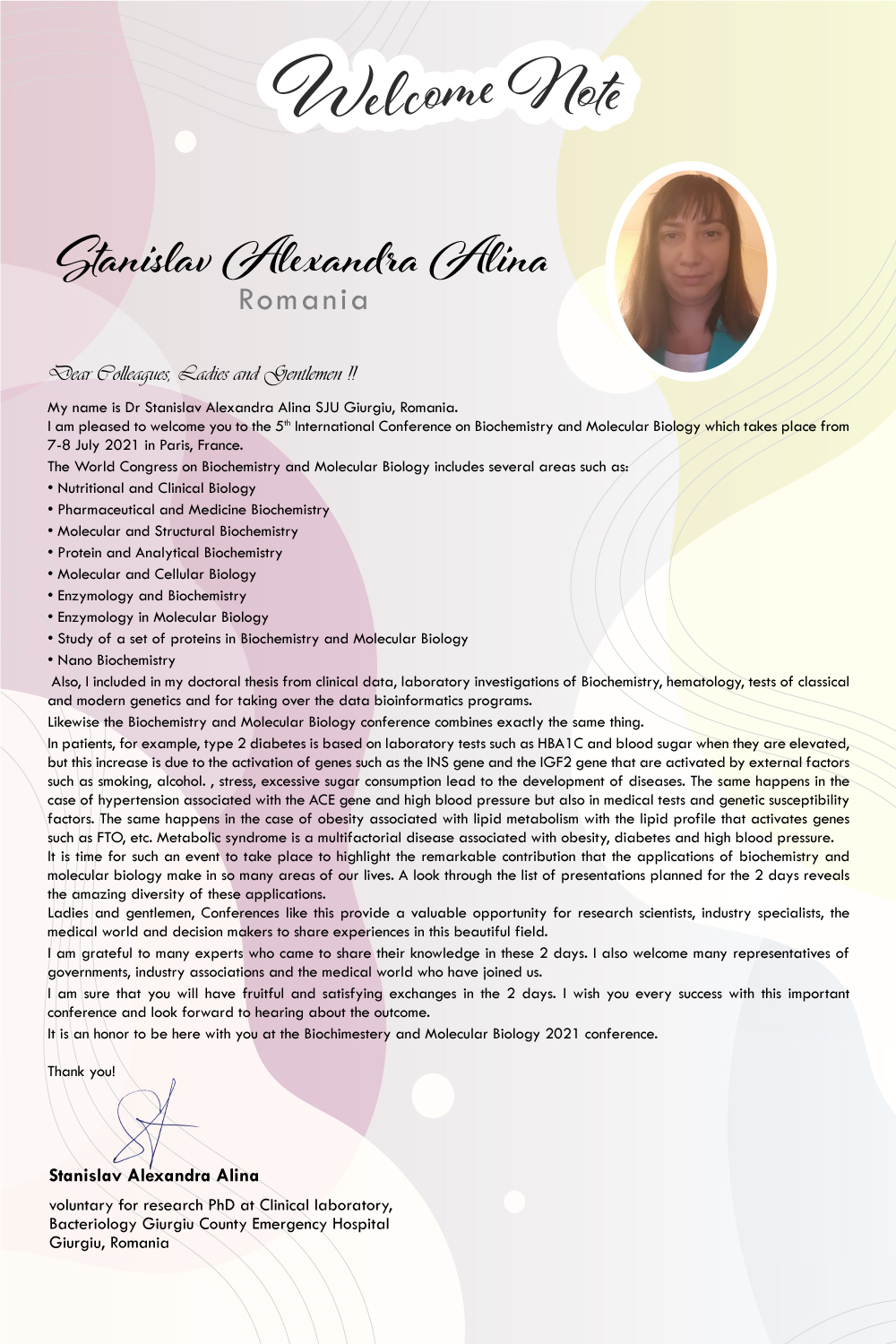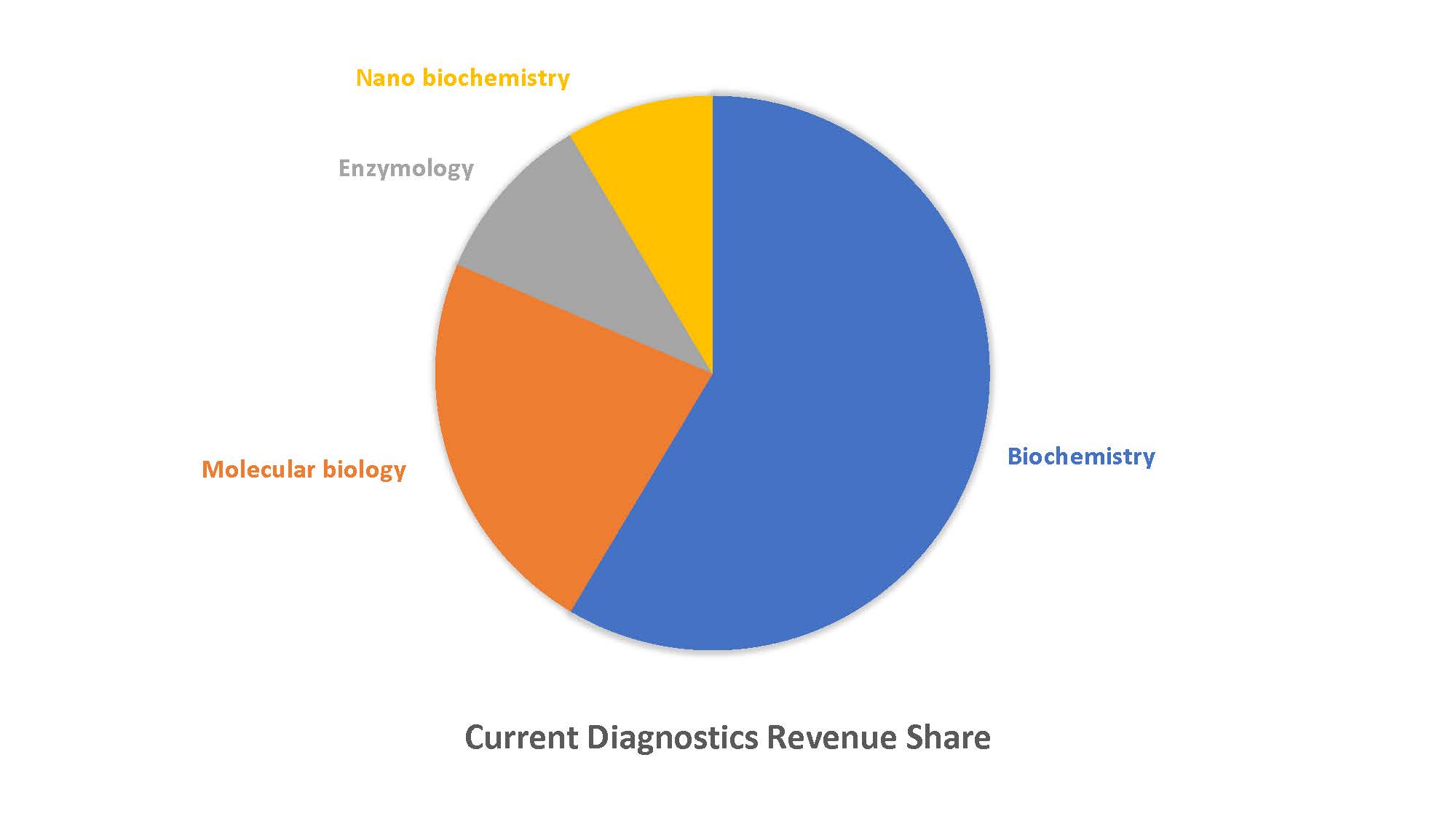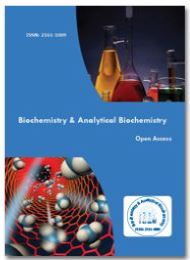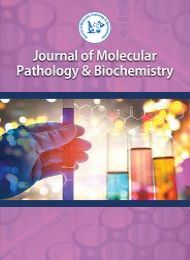Theme: Explore the Biochemistry and Related Fields
Biochemistry 2021


The conference is about the application of chemistry to the study of biological processes at the cellular and molecular level. The conference comprises of keynote presentations, verbal speeches, poster presentations and exhibitions providing the insight of biochemistry and its application and importance and Molecular Biology fields. The main theme of the conference is “Explore the Biochemistry and related fields”. The date of conference is 07-08 July 2021.
Biochemistry is that the application of chemistry to the study of biological processes at the cellular and molecular level. It uses the methods of chemistry, physics, biology and immunology to review the structure and behavior of the complex molecules found in biological material and therefore the ways these molecules interact to make cells, tissues and whole organisms. It underlies and includes such exciting new fields as genetics and bioengineering. Biochemistry is additionally unique in providing teaching and research in both protein structure/function and gene-splicing.
Biochemistry also includes many subspecialties like neurochemistry, bioorganic chemistry, clinical biochemistry, physical biochemistry, genetics, biochemical pharmacology and immunochemistry.
Target Audience
- Biotechnologist
- Research Scientist
- Clinical Scientist
- Research Associates
- Chemist Microbiologist
- Biomedical Scientist
- Pharmacologist
- Laboratory Technician
- Lecturer in an Educational institution
- Medical Institutes
- Hospitals
- Research Institutes
Why to attend?
Biochemistry and molecular biology conference focuses on creating an international platform for the participants to share their knowledge and research work on the respective fields. It will include various tracks and sub-tracks within the biochemistry and molecular biology field, which will further allow the participants to chose their respective tracks of their interests. The conference will give an opportunity to explore the topic with highly qualified researchers, scientists, doctors, professors and related people and associations who are involved in this field. It will be a great opportunities for the young researchers as well to learn and explore about their respective fields in Biochemistry and Molecular Biology.
Track 1: Nutritional and Clinical Biology
Nutritional biochemistry maintains with the perception of mechanism by which diet influences human health & illness condition. It principally contributes with the properties of nutrients, different dietary substitutes & the study of their physiological, metabolic, biochemical & genetic functions. Clinical biochemistry uses an honest vary of analytical techniques with its applications principally in clinical chemistry, biology, toxicology, laboratory immunology & medicine used for diagnosing, prognosis, medical care and cure of disease.
Clinical biochemistry
Nutritional Biochemistry
Properties of nutrients
Study of biochemical and genetic function
Application of clinical biology
Track 2: Pharmaceutical and Medicine Biochemistry
Medicinal biochemistry is that branch of medicine involved the biochemistry and metabolism of human health and sickness. The medical chemist is trained within the operation and management of clinical biochemistry laboratories, and acts as an authority altogether aspect of their use. It principally issues with the science of drugs, their clinical uses and thus the study of their adverse effects on living organisms. It provides an entire understanding of all chemical processes occurring and related to living cells at the molecular level that's associated with drug action. It conjointly helps to acquire data on the adverse effects, molecular targets, & characterization of medicine or different chemical substance within the living cells & organisms.
Medicinal biochemistry
Characteristics of medical biochemistry
Principals issues of Medical biochemistry
Uses of medical biochemistry
Chemical process within living cells
Track 3: Molecular and Structural Biochemistry
Structural Biochemistry is a sub-division of biochemistry that mainly focuses on the structural characteristics of the molecules within the cells and other made from living organisms. The main area is concentrated on structural basis of fundamental biological processes. It involves the study of the structure of macro molecules. It includes methods for structure determination and large data of structural information. Few of the tools are going to be wont to study some class of structures like membrane, regulatory proteins, and structural proteins. These structural macromolecules will provide the framework for discussion on domains, motifs, structural homology, etc., also as addressing on how specific biological problems are often solved at the atomic level.
Structural biochemistry
Characteristics of molecules within the living cells
Study of macro molecules
Specific biological problems solved at atomic level
Track 4: Protein and Analytical Biochemistry
Proteins offer most of the molecular machinery of cells. Several square measure enzymes or subunits of enzymes. Alternative proteins play structural or mechanical roles, like those that kind the struts and joints of the structure.
Every macromolecule is linear polymers designed of amino acids. Analytical biochemistry can be mentioned as a study of biochemical components found in a cell or other biological sample. This field uses a broad vary of techniques for separation, identification, quantification and practical characterization of biological molecules like nucleic acids, enzymes, proteins, pigments, carbohydrates and further.
Analytical Biochemistry
Protein Biochemistry
Characteristics of analytical biochemistry
Relativity of protein and analytical biochemistry
Track 5: Molecular and Cellular Biology
Cell and biology is an interdisciplinary field of science that deals with the fields of chemistry, structure and biology because it seeks to know life and cellular processes at the molecular level.
Study of cellular biology
Study of cellular biology at molecular level
Molecular biology
Track 6: Enzymology and Biochemistry
Biochemistry, sometimes called biological chemistry, is that the study of chemical processes within and concerning living organisms. By controlling information flow through biochemical signaling and therefore the flow of energy through metabolism, biochemical processes produce to the complexity of life. Over the last decades of the 20th century, biochemistry has become so successful at explaining living processes that now most areas of the life sciences from botany to medicine to genetics are engaged in biochemical research.
Relation between Enzymology and Biochemistry
Study of relationship between structure and function of enzymes
Techniques of pre-study-stake kinetic experiments
Characteristics of enzymology
determination of enzyme catalytic mechanisms
Track 7: Enzymology in Molecular Biology
Molecular enzymology is designing and synthesis of enzymes and high unmet medical needs are based on innovative drug targets. The work of designing and synthesis of enzymes and high unmet medical need are supported innovative drug targets. Molecular Enzymology's interest include altogether aspects associated with enzymes like discovery of enzymes, enzyme structure, enzyme mechanisms, cellular and metabolic functions of enzymes, exploitation of enzymes for biotechnological and pharmaceutical applications, drug discovery, biochemical aspects of enzymes, bioinformatics, computational analysis, molecular modeling studies, new methods in enzyme expression and purification, bio catalysis, bio molecular engineering, enzyme kinetics and inhibitors.
Role of Enzymology in complex Molecular biology process
Reactions and evolutions
Track 8: Study of a set of proteins in Biochemistry and Molecular Biology
Molecular Enzymology's interest include altogether aspects associated with enzymes like discovery of enzymes, enzyme structure, enzyme mechanisms, cellular and metabolic functions of enzymes, exploitation of enzymes for biotechnological and pharmaceutical applications, drug discovery, biochemical aspects of enzymes, bioinformatics, computational analysis, molecular modeling studies, new methods in enzyme expression and purification, bio catalysis, bio molecular engineering, enzyme kinetics and inhibitors.
Track 9: Nano Biochemistry
The science of Nano scale structures deals with the investigation moreover as utilization of parts or systems that are 109 times smaller than the standard size of parts. Consolidation of these two technologies resulted in starting of Nano biochemistry. This knowledge base combination of applied science & biochemistry will produce various innovative tools. Application of engineering to biological sciences indicates creation of materials and devices designed to act at intervals the body with high degree specificity. This could be presumably accustomed target cellular and tissue-specific clinical applications that are directed at top therapeutic effects with no adverse-effects.
Biosensors
Nano medicines and interactions
Bio molecular detection strategies
Structural DNA nanotechnology
Track 10: Cardiovascular Biochemistry
Cardiac Biochemistry is that the biochemical mechanisms and properties underlying normal cardiovascular function and diseases like coronary failure. The circulatory system and therefore the biochemistry of grafts utilized in operation.
Calcium signaling in cardiac and skeletal muscles
Cardiovascular genetic and genomic sciences
Cardiac electrophysiology
Molecular approaches to heart disease
Track 11: Pharmacology and Toxicology
Pharmacology is a neighborhood of science which relates to the invention, chemistry, composition, identification, biological and physical effects, uses and manufate of medicine. Pharmacology is usually mistaken for pharmacy, which may be a profession involving the preparation, and dispensing of medicine. Toxicology may be a branch of biology, chemistry, and medicine concerned with the study of the adverse effects of chemicals on living organisms. It also studies the harmful effects of chemical, biological and physical agents in biological systems that establish the extent of injury in living organisms.
Cardiovascular pharmacology
Neuropsychopharmacology
Clinical toxicology
Regulatory toxicology
Track 12: Medical Genetics
The science of Medical biology cares with the physical and chemical characteristics of genes and their expression that controls the event & maintenance of the organism. The sector of medical genetics is quite new & presently accustomed describe the rationale behind many inherited diseases. The unwellness usually results in generation of unreliable proteins like in cases of haemophilia then quite 2 hundred 'inborn errors' of metabolism are recognized in animals, unwellness conditions like mannosidosis & galactosemia occur thanks to lack of a selected protein/enzyme that prohibits metabolism of carbohydrates, proteins, fats & thus shows clinical signs.
Genetics and its application on Medical care
Genomics
Pharmacogenetics
Track 13: Clinical Pathology
Clinical pathology also has improved in technology field. In the recent times it's introduced image digitizing technology, which makes easy for the viewers of the results or the lab technician.
Disease diagnosis
Blood bank
Immunology and serology
Microbiology
Track 14: Structural Biochemistry
Structural biochemistry is a branch of biology, biochemistry, and biophysics. Structural biology is that the study of the 3D structure of biologically important molecules and macromolecules like proteins, nucleic acids and carbohydrates. The 3D structures of those molecules generally define their function. Biomolecules are too small to ascertain intimately even with the foremost advanced light microscopes
Bio-organic Chemistry
Molecular biology
Track 15: Structural Molecular Biochemistry and Structural Bioinformatics
Structural biology with generalizations about macromolecular 3D structure like comparisons of overall folds and native motifs, principles of molecular folding, evolution, and binding interactions, and structure/function relationships, working both from experimentally solved structures and from computational models. Structural biology may be a branch of biology, biochemistry, and biophysics concerned with the molecular structure of biological macromolecules, especially amino and nucleic acids, how they acquire the structures they have, and the way alterations in their structures affect their function.
Computational structural biology
Molecular mechanism of proteins
Drug discovery
Track 16: Chemical Biology and Computational Chemistry
Computational chemistry may be a branch of chemistry that uses simulation to help in solving chemical problems. Biochemistry is that the study of the chemistry of biology. It encompasses topics like understanding how proteins are translated and peptide bonds formed, how macromolecular interactions occur, how the cell makes metabolites, etc.
Nucleic acid and Protein sequence research
Molecular evolution
Molecular genetics
Track 17: Plant Animal Biochemistry
Animal Biochemistry is that the study of various chemical reactions happening within the body of animal for all times. Plant biochemistry isn't only a crucial field of basic science explaining the molecular function of a plant, but is additionally an engineering that's within the position to contribute to the answer of agricultural and pharmaceutical problems. It is expected that within the future, gene technology will cause the extensive use of plants as a way of manufacturing sustainable staple for industrial purposes. As such, the techniques and use of gene-splicing to enhance crop plants and to supply sustainable raw materials for the chemical and pharmaceutical industries are described during this edition. The latest research findings are included, and areas of future research are identified.
Inheritance study
Disease diagnosis
Genetic engineering
Vetnary science and animal husbandry
Plant protection and fertilization
Track 18: Lipids and Metabolism
Lipid metabolism is that the break down or storage of fats for energy; these fats are obtained from consuming food and absorbing them or they're synthesized by an animal's liver.
Oxidation of fatty acids
Carbohydrate metabolism
Ketogenesis
Lipogenesis
Track 19: Molecular Virology
Molecular virology is that the study of viruses on a molecular level. Viruses are submicroscopic parasites that replicate inside host cells. They’re ready to successfully infect and parasitize all types of life forms- from microorganisms to plants and animals- and as a result viruses have more biological diversity than the remainder of the bacterial, plant, and animal kingdoms combined. Studying this diversity is that the key to a far better understanding of how viruses interact with their hosts, replicate inside them, and cause diseases.
Viral Immunoprophylaxis
Antiviral therapy
Antibodies
Track 20: COVID 19 and Biochemistry
Several laboratories in biochemistry are engaged in COVID 19 research for various purpose such as chemical reactions of the virus with various chemicals in body, pharmaceutical purpose. Number of research has come to positive results which further helped in production of Vaccine.
Causative agent of COVID-19 – (SARS-COV-2 )
Cardiovascular system
Pharmacology
Dysregulation of cellular function in disease
Molecular and cell biology
Physiology in the regulation of tissue function in health and disease.
Track 21: Biochemistry and Material Science
Catalysis, Complexes and Proteins unlocks recent developments within the field of biochemistry through a series of case studies, enabling materials scientists to harness these advances for innovation in their own field, from the planning of bio-inspired materials, to the utilization of latest classes of catalyst. Biochemistry for Material Science include an introduction to seven recent discoveries, a discussion of the elemental knowledge and techniques of biochemistry, a look at variety of biochemical materials, and an enquiry of the areas of bioscience, chemistry and inorganic-related materials. The book concludes with a discussion of cosmochemistry.
Presents recent developments in biochemistry which will be harnessed for innovation in materials science
Utilizes case studies for instance the appliance of varied biochemistry concepts
Provides readers with the elemental knowledge of basic chemistry concerning life-forming materials, catalysis, etc.
Track 22: Molecular Biology and Material Science
Nanostructures are the fundamental machines that drive the cell histones and proteasomes and they are components of the mitochondrion, the chloroplast, the ribosome, and the replication and transcription complexes. In catalysis, nanostructures are the templates and pores of zeolites and other vitally important structures. The nanometer length scale is that the largest one over which a crystal are often made essentially perfect. The ability to precisely control the arrangements of impurities and defects with regard to each other, and thus the power to integrate perfect inorganic and organic nanostructures, holds forth the promise of a totally new generation of advanced composites.
Biochemistry Market report gives an entire scene of the business, right advertise gauges and estimate split by item, application, innovation, area and end-use. with development slants, various partners like financial specialists, CEOs, merchants, providers, investigation and media, universal Manager, Director, President, SWOT examination for example Quality, Weakness, Opportunities and Threat to the association and others. This report centers on Professional Global Biochemistry Analyzer Market 2019-2024 volume and incentive at Global level, territorial level and friends level. The Global Enzymes showcase was regarded at $10.48 billion out of 2018 and is required to succeed in at a CAGR of 8.9% from 2019 to 2025. Catalysts are biocatalysts that enliven the reaction and convey the pined for results in natural reactions.

The overall market for Biochemistry Analyzer is required to develop at a CAGR of generally xx% throughout the subsequent five years, will reach xx million US$ is 2023, from xx million US$ in 2017, as indicated by another GIR (Global) study Its objective is to possess 10% by 2020 of all vehicle energizes sourced from the sustainable source like biofuel in its part nations. A few nations of governments (Germany, Sweden, France and Austria) taking out approaches of organizing biodiesel generation. In coming a long time in Europe I will be able to see a development within the chemical market.

The report, the Global Biochemistry Analyzers, Market Report has been prepared based on an in-depth marketing research with inputs from industry experts. The report covers the Americas, and therefore the EMEA and APAC regions. It also covers the Global Biochemistry Analyzers market landscape and its growth prospects within the Further The report also includes a discussion of the key vendors operating in this market. The analysis was done using an objective combination of primary and secondary details including inputs from key participants within the industry. The market is predicted to succeed in $29.4 billion in 2020 from $25.3 billion in 2015 increasing at a CAGR of three .1%. Asia is that the fastest growing region of the worldwide IVD market with a CAGR of 12.9% from 2015 to 2020. The market is worth $15.3 billion in 2015 and is predicted to succeed in $28.2 billion by 2020.

Societies Related to Biochemistry and Molecular Biology
- Australasian Association of Clinical Biochemists (AACB)
- Australian Society of Biochemistry and Molecular Biology
- Belgian Society of Biochemistry and Molecular Biology
- Biochemistry and Biomedical Sciences Society (BBSS)
- Egyptian society of Biochemistry and Molecular Biology
- Federation of European Biochemical Societies
- Hong Kong Society of Biochemistry and Molecular Biology
- International Society of Nucleosides, Nucleotides, & Nucleic Acids
- International Union of Biochemistry and Molecular Biology
- The Israel Society for Biochemistry and Molecular Biology
- The Italian Society of Clinical Biochemistry and Clinical Molecular Biology
- The Nigerian Society of Biochemistry and Molecular Biology
- The Slovak Society for Biochemistry and Molecular Biology
- The South African Society for Biochemistry and Molecular Biology
Major Companies Related to Biochemistry and Molecular Biology
- Thermo Fisher Scientific Inc. (USA)
- Pfizer (USA)
- Merck (USA)
- Novo Nordisk (Denmark)
- GlaxoSmithKline (UK)
- Bristol-Myers Squibb (USA)
- Biocrates (Austria)
- Gilead Sciences (USA)
- Biogen Idec, (USA)
- Celgene, USA
- Shire Pharmaceuticals (Ireland)
Conference Highlights
- Nutritional and Clinical Biology
- Pharmaceutical and Medicine Biochemistry
- Molecular and Structural Biochemistry
- Protein and Analytical Biochemistry
- Molecular and Cellular Biology
- Enzymology and Biochemistry
- Enzymology in Molecular Biology
- Study of a set of proteins in Biochemistry and Molecular Biology
- Nano Biochemistry
- Cardiovascular Biochemistry
- Pharmacology and Toxicology
- Medical Genetics
- Clinical Pathology
- Structural Biochemistry
- Structural Molecular Biochemistry and Structural Bioinformatics
- Chemical Biology and Computational Chemistry
- Plant Animal Biochemistry
- Lipids and Metabolism
- Molecular Virology
- COVID 19 and Biochemistry
- Biochemistry for Materials Science
- Molecular Biology and Material Science
To share your views and research, please click here to register for the Conference.
To Collaborate Scientific Professionals around the World
| Conference Date | July 26-27, 2021 | ||
| Sponsors & Exhibitors |
|
||
| Speaker Opportunity Closed | |||
| Poster Opportunity Closed | Click Here to View | ||
Useful Links
Special Issues
All accepted abstracts will be published in respective Our International Journals.
- Biochemistry & Molecular Biology Letters
- Biochemistry & Analytical Biochemistry
- Journal of Molecular Pathology and Biochemistry
Abstracts will be provided with Digital Object Identifier by










